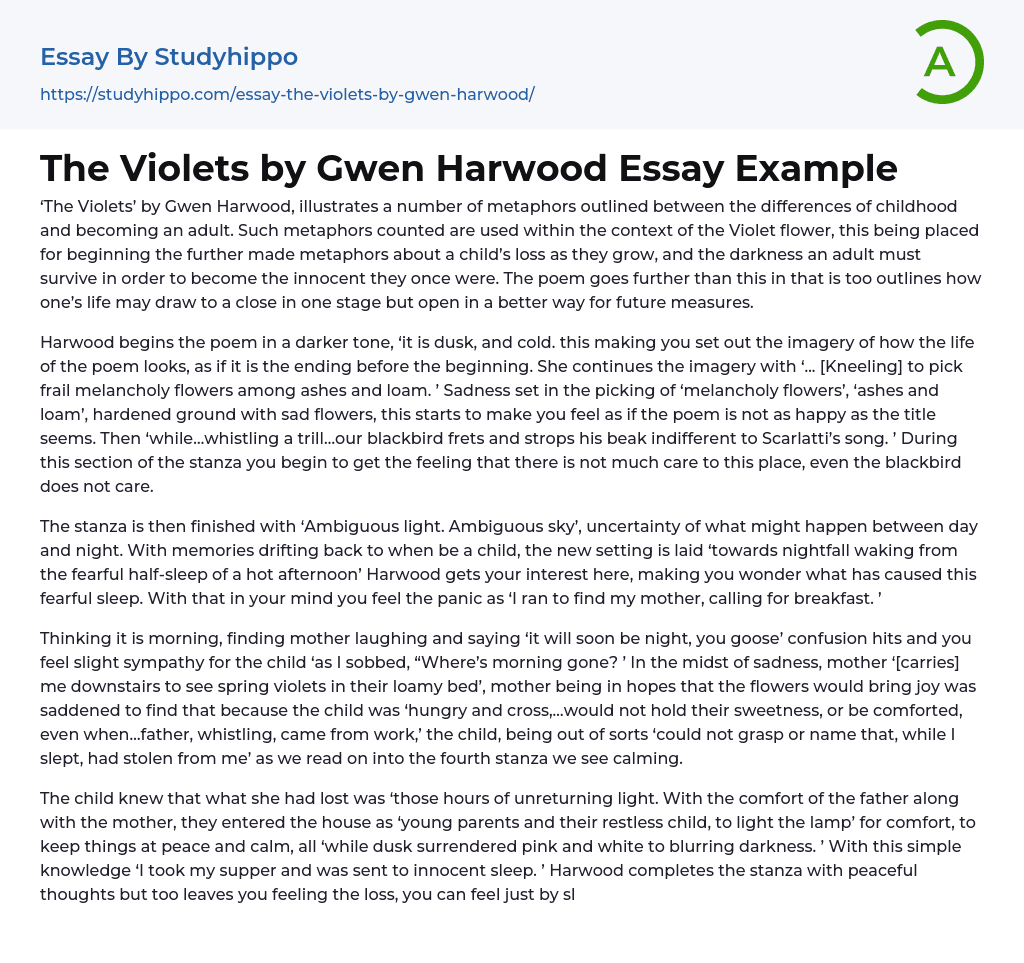‘The Violets’ by Gwen Harwood, illustrates a number of metaphors outlined between the differences of childhood and becoming an adult. Such metaphors counted are used within the context of the Violet flower, this being placed for beginning the further made metaphors about a child’s loss as they grow, and the darkness an adult must survive in order to become the innocent they once were. The poem goes further than this in that is too outlines how one’s life may draw to a close in one stage but open in a better way for future measures.
Harwood begins the poem in a darker tone, ‘it is dusk, and cold. this making you set out the imagery of how the life of the poem looks, as if it is the ending before the beginning. She continues the imagery with ‘... [Kne
...eling] to pick frail melancholy flowers among ashes and loam. ’ Sadness set in the picking of ‘melancholy flowers’, ‘ashes and loam’, hardened ground with sad flowers, this starts to make you feel as if the poem is not as happy as the title seems. Then ‘while…whistling a trill…our blackbird frets and strops his beak indifferent to Scarlatti’s song. ’ During this section of the stanza you begin to get the feeling that there is not much care to this place, even the blackbird does not care.
The stanza is then finished with ‘Ambiguous light. Ambiguous sky’, uncertainty of what might happen between day and night. With memories drifting back to when be a child, the new setting is laid ‘towards nightfall waking from the fearful half-sleep of a hot afternoon’ Harwood gets
your interest here, making you wonder what has caused this fearful sleep. With that in your mind you feel the panic as ‘I ran to find my mother, calling for breakfast. ’
Thinking it is morning, finding mother laughing and saying ‘it will soon be night, you goose’ confusion hits and you feel slight sympathy for the child ‘as I sobbed, “Where’s morning gone? ’ In the midst of sadness, mother ‘[carries] me downstairs to see spring violets in their loamy bed’, mother being in hopes that the flowers would bring joy was saddened to find that because the child was ‘hungry and cross,…would not hold their sweetness, or be comforted, even when…father, whistling, came from work,’ the child, being out of sorts ‘could not grasp or name that, while I slept, had stolen from me’ as we read on into the fourth stanza we see calming.
The child knew that what she had lost was ‘those hours of unreturning light. With the comfort of the father along with the mother, they entered the house as ‘young parents and their restless child, to light the lamp’ for comfort, to keep things at peace and calm, all ‘while dusk surrendered pink and white to blurring darkness. ’ With this simple knowledge ‘I took my supper and was sent to innocent sleep. ’ Harwood completes the stanza with peaceful thoughts but too leaves you feeling the loss, you can feel just by sleeping through midday.
Finishing this stanza with half a sentence reading ‘Years cannot move’, before you continue reading, if you pause at this you see that yes time moves past and behind
us, but the years themselves never move from the place they are set. Gwen reminds us that ‘nor death’s disorienting scale distort those lamplit presences’ that when you are in darkness, you will have more trouble finding those ‘lamplit presences’ of those around you for help.
Furthering the ending to the poem we are brought to the closing of a child’s day. ‘a child with milk and story-book’ comfort and warmth, ‘my father bending to inhale the gathered flowers’ the appreciation of what the mother and child had done, ‘with tenderness stroking my mother’s goldbrown hair’ the knowing that this is family, comfortable and safe.
With the ‘Stone-curlews call’ it’s symbolised that it is late night, then with the ‘Faint scent of violets [drifting] in the air’ the memory is closed with that which brought the memory on... Violets. Gwen Harwood brings childhood, to the adult in this poem. Making the reader more inclined to be drawn in and feel the emotion behind. With each word written and the style the poem has been written in you can both tell and feel where Harwood has lead you into the memory of past from the present.
- Canterbury Tales essays
- Dulce Et Decorum Est essays
- My Last Duchess essays
- Beowulf essays
- Sir Gawain And The Green Knight essays
- The Road essays
- Aeneid essays
- Odyssey essays
- Blackberry Picking essays
- Beowulf Epic Hero essays
- Child essays
- Child labor essays
- Childcare essays
- American Literature essays
- Between The World and Me essays
- Book Report essays
- Book Review essays
- Book Summary essays
- Books essays
- Character essays
- Coming of Age essays
- Dante's Inferno essays
- Everyday Use essays
- Flowers for Algernon essays
- Genre essays
- Greek Mythology essays
- Incidents in The Life of a Slave Girl essays
- Letter essays
- Literary Criticism essays
- Literary devices essays
- Literature Review essays
- Metaphor essays
- Myth essays
- Play essays
- Plot essays
- Poem essays
- Poetry Analysis essays
- Protagonist essays
- Reader essays
- Reason essays
- Rhetoric essays
- Rhetorical Question essays
- Rhyme essays
- Simile essays
- Tragic Hero essays
- Translation essays
- Understanding essays
- Utopia essays
- Villain essays
- Writer essays




